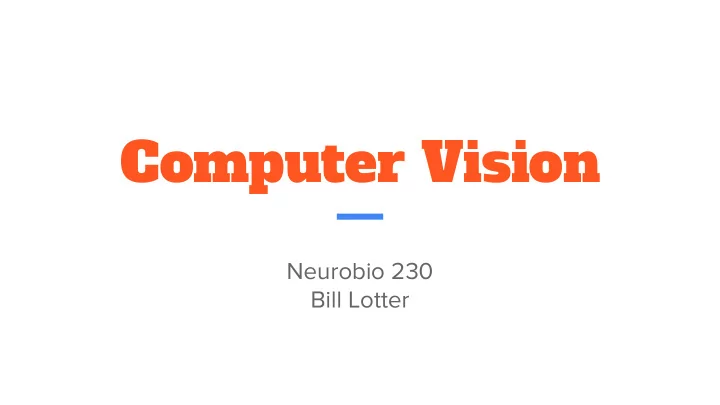

Computer Vision Neurobio 230 Bill Lotter
Exciting time: Neuroscience ⇔ computer vision -Traditionally: computer vision relied on hand crafted features -Today: “Deep Learning” -loosely based on how the brain does computations -most of components learned from data -a lot of commonalities between computer vision models and the visual ventral stream in the brain
Overview of Computer Vision Problems Object Recognition Image Segmentation Optical Character Recognition Face Identification Action Recognition ... Applications to: photography, self-driving cars, medical imaging analysis,..
Common Testbeds for Computer Vision MNIST LFW Imagenet
General Problem Formulation Handcrafted Learned Readout Pre ~2012: Pixels Features (ex. SVM) Post 2012: Learned Features Pixels and Readout
Focusing on Object Recognition: Convolutional Neural Networks (CNNs) Background: Hubel and Wiesel Simple and Complex Cells (1959, 1960s) Neocognitron (Fukushima, 1980) HMAX (Riesenhuber & Poggio 1999, Serre, Kreiman et al. 2007) Yann LeCun’s work on MNIST with CNNs (1998)
What is an Artificial Neural Network? a lot of variations, hard to generalize, but a simple ANN looks something like this..
Training the Network: Backprop Backpropagation (Rumelhart, Hinton, Williams 1986): way to calculate gradient of error in terms of network parameters Today: gradient descent with some bells and whistles
Formulating for object recognition... hidden input output: class probabilities pixels cat W x W y spatula unroll ugly dog
Taking a look at parameters.. image: 256x256x3 = 196,608 inputs outputs: 1000 categories even if just go directly from image to outputs: 1000 x 196,608 = 196 million params!! even if you have 1 million training images, you would severely overfit the network
Using Convolutions Natural images aren’t just random arrays, they have structure Two things to exploit while designing networks: locality and ~spatial invariance Relating to neuroscience: weights for a given unit can be thought of as receptive field pixels firing rate = dot product between W x pixels and weights unroll
Using Convolutions Natural images aren’t just random arrays, they have structure Two things to exploit while designing networks: locality and ~spatial invariance Relating to neuroscience: weights for a given unit can be thought of as receptive field pixels firing rate = dot product between W x pixels and weights unroll
Using Convolutions Weights as receptive fields: localized and can replicate over visual field => It makes sense to use convolutions * = response of that receptive field at that location
Using Convolutions Full formulation: layers have “depth” as well (x, y) pixel position and 3 color channels We want a bunch of different filters to convolve the image with input image have N different filters 256 * 3 3 N nx 256
Incorporating other stuff we know is important in biology Hierarchy: ventral stream has several layers (V1, V2,...) Neurons are non-linear: common non-linearity used today is rectified linear units (don’t allow neurons to have negative firing rate) “Complex”-type cells: incorporating pooling
Putting it all together... Krizhevsky et al. 2012 (Alexnet)
Comparing with Biology Similarities Differences hierarchical backprop receptive fields get bigger as go higher supervised vs. unsupervised learning first layer trained weights look like V1 final model is purely feedforward receptive fields
Other Cool Stuff Learned feature representations are generalizable can do other tasks like object localization (Oquab et al. 2015) people use Alexnet feature representations as input to many other problems Inverting convolutional neural networks train another network to go from feature representation back to pixel space (Dosovitskiy 2015) can see what different layers represent
Other Cool Stuff The more predictive a model is of neural data, the better it is at performance (Yamins 2014)
Other Cool Stuff Nonetheless, it is easy to fool convnets (Szegedy 2013) classified as ostrich
Final Thoughts Still far away from making machines that can perform as well as humans, but making steady progress by designing models that share many features with brain Neuroscience has informed computer vision, but computer vision models also allow for testing of neuroscience theories much easier to do “neuroscience” on models than real brains
Recommend
More recommend